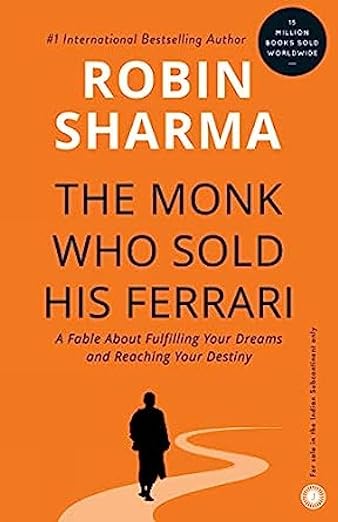
The Monk Who Sold His Ferrari by Robin Sharma: Book Review
The Monk Who Sold His Ferrari by Robin Sharma: Book Review
This book in 2025 is moreover, an inspiring and transformative book in 2024 that describes the journey of self-discovery and personal development with life lessons. The author, a renowned leadership expert, presents these lessons through the story of Julian Mantle, a high-powered lawyer whose life takes a drastic turn. The book blends spirituality, mindfulness, and motivational advice to guide readers toward a more fulfilling and meaningful life.
The Monk Who Sold His Ferrari by Robin Sharma: Book Review | Plot Summary
The narrative begins with Julian Mantle, a successful but overworked and stressed lawyer, who experiences a near-fatal heart attack in the courtroom. This wake-up call prompts him to sell his possessions, including his prized Ferrari, and embark on a journey to the Himalayan mountains. There, he meets the Sages of Sivana, who impart timeless wisdom and principles for a balanced, joyous life.
Julian returns to share his newfound knowledge with his former colleague, John. Through a series of conversations, Julian however, unveils the secrets he learned from the sages, structured around seven core principles. These principles help individuals achieve enlightenment, cultivate self-discipline, and embrace a life of purpose.
The Monk Who Sold His Ferrari by Robin Sharma | Themes and Lessons
1. Master Your Mind
The character also emphasizes the importance of nurturing the mind and filling it with positive thoughts. By removing negative thoughts and planting seeds of positivity, one can create a space for growth and happiness.
2. Follow Your Purpose
Julian also teaches that having a clear sense of purpose gives life direction and meaning. He encourages setting personal, professional, and spiritual goals to stay aligned with one’s true calling. This pursuit of purpose is what brings fulfillment and satisfaction.
3. Practice Kaizen
The Japanese philosophy of Kaizen, meaning continuous improvement, is also advocated as a way to achieve excellence. Julian suggests that small, incremental changes in daily habits can lead to significant personal growth. This principle encourages readers to constantly seek ways to improve themselves, whether through learning, developing new skills, or enhancing their well-being.
4. Live with Discipline
Julian introduces the concept of willpower as a muscle that can be strengthened with practice. By cultivating discipline, individuals can overcome obstacles, stay committed to their goals, and maintain focus on their path to self-mastery.
5. Respect Your Time
Julian stresses the importance of valuing time as a precious resource and using it wisely. Techniques such as setting priorities, avoiding distractions, and dedicating time to activities that align with one’s goals are emphasized to ensure that time is spent meaningfully.
6. Selflessly Serve Others
Julian explains that selfless service boosts a sense of connection and purpose, enriching both the giver and the receiver. Acts of kindness and generosity not only benefit others but also contribute to one’s happiness and sense of worth.
7. Embrace the Present
Living in the present moment is moreover, a key principle taught by the sages. Julian advocates for mindfulness and being fully engaged in the present rather than dwelling on the past or worrying about the future. This mindfulness practice leads to a greater appreciation of life’s simple pleasures and reduces stress and anxiety.
Writing Style and Structure
Robin Sharma employs a simple writing style that makes the book accessible and engaging. The story format, with its narrative-driven approach, effectively conveys complex concepts easy to understand. The dialogues with Julian make the lessons in the book more clear.
The book’s structure is also straightforward, with each chapter dedicated to one of the seven principles. This organization allows readers to focus on one lesson at a time and reflect on its application in their own lives. Additionally, Sharma includes actionable steps and exercises at the end of each chapter, encouraging readers to implement the teachings actively.
Impact and Reception
The Book has also resonated with a wide audience, earning a place among the most popular self-help books. Its timeless wisdom, presented through an engaging story, has moreover, inspired countless readers to embark on their journeys of self-improvement and spiritual awakening. The book’s success has led to numerous translations, adaptations, and sequels, further expanding its reach and influence.
Critics have also praised the book for its practical approach and motivational message, but some say the principles are common and can be found elsewhere easily. Despite this, the unique narrative format and Sharma’s engaging writing have made these lessons accessible and impactful for a broad audience.
The Monk Who Sold His Ferrari by Robin Sharma | Conclusion
The Monk Who Sold His Ferrari by Robin Sharma is a powerful and inspiring guide to personal transformation. Through the story of Julian Mantle, readers are introduced to essential principles for living a balanced, purposeful, and fulfilling life. The book’s blend of spiritual wisdom, practical advice, and engaging storytelling makes it a valuable resource for anyone seeking to improve their life and achieve inner peace. Whether you are new to self-help literature or a seasoned reader, this book offers timeless lessons that can benefit anyone on their journey of self-discovery and growth.
Also Read, “ The 5 AM Club” By Robin Sharma
If you like my article, do share it with your friends and someone who requires to read this article. Click on the notification and don’t forget to follow my website Perfect Quotes for You for more such articles. Also don’t forget to share it on social media platforms by clicking on the social media icons below. Feel free to Drop a comment or ask any questions.
Good news for all my beloved readers! My name is Vinay and I have started life coaching to guide you in your life journey. I help you find answers to the questions you always wanted to know and acknowledge. Feel free to drop a WhatsApp text, give a call, or send a message in the chat box of my blog.











